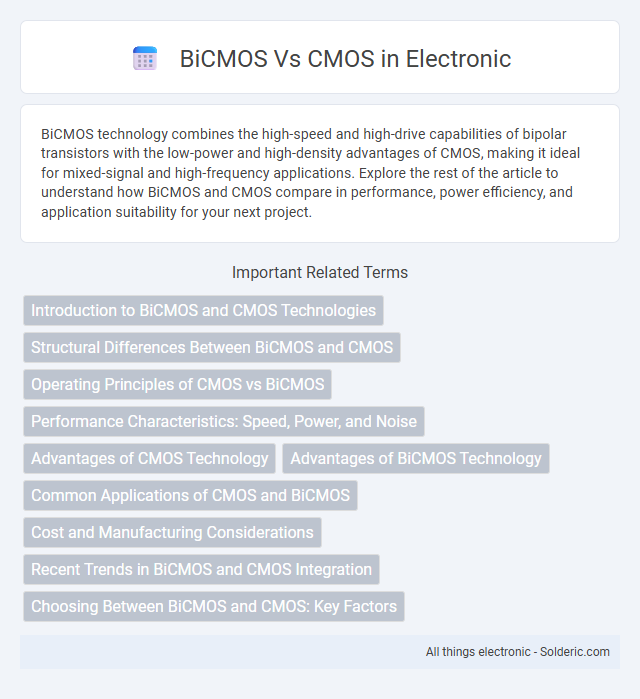BiCMOS technology combines the high-speed and high-drive capabilities of bipolar transistors with the low-power and high-density advantages of CMOS, making it ideal for mixed-signal and high-frequency applications. Explore the rest of the article to understand how BiCMOS and CMOS compare in performance, power efficiency, and application suitability for your next project.
Comparison Table
| Feature | BiCMOS | CMOS |
|---|---|---|
| Technology | Combination of Bipolar Junction Transistors (BJT) and CMOS | Complementary Metal-Oxide-Semiconductor |
| Speed | Higher speed due to BJTs | Moderate speed, limited by MOSFETs |
| Power Consumption | Higher static power consumption | Low static and dynamic power consumption |
| Cost | More expensive due to complex process | Lower fabrication cost |
| Drive Capability | Strong drive current with BJTs | Weaker drive current compared to BiCMOS |
| Applications | Analog-digital mixed circuits, high-speed amplifiers, RF circuits | Digital ICs, low power applications, microprocessors |
| Integration Complexity | Higher, due to combining bipolar and CMOS | Lower, simpler fabrication process |
Introduction to BiCMOS and CMOS Technologies
BiCMOS technology combines Bipolar Junction Transistors (BJTs) and Complementary Metal-Oxide-Semiconductor (CMOS) transistors, offering high speed and low power consumption in integrated circuits. CMOS technology, widely used in digital circuits, emphasizes energy efficiency and high density through complementary p-type and n-type MOSFETs. Your choice between BiCMOS and CMOS depends on the specific needs for performance, power, and integration complexity in your electronic design.
Structural Differences Between BiCMOS and CMOS
BiCMOS technology integrates both Bipolar Junction Transistors (BJTs) and Complementary Metal-Oxide-Semiconductor (CMOS) transistors on a single chip, enhancing speed and output drive capabilities compared to CMOS-only structures. The structural difference lies in BiCMOS employing bipolar transistors for high current drive and fast switching, alongside CMOS transistors for low power consumption and high input impedance. CMOS technology solely uses complementary pairs of p-type and n-type MOSFETs, prioritizing energy efficiency and scalability in integrated circuits.
Operating Principles of CMOS vs BiCMOS
CMOS technology operates using complementary pairs of p-type and n-type MOSFETs to efficiently switch digital signals with low power consumption. BiCMOS integrates both bipolar junction transistors (BJTs) and CMOS transistors, combining high-speed switching capabilities with low static power dissipation. The bipolar transistors in BiCMOS provide high gain and fast current drive, enhancing analog performance, while CMOS transistors ensure low power digital logic operation.
Performance Characteristics: Speed, Power, and Noise
BiCMOS technology combines bipolar junction transistors (BJTs) with CMOS transistors, offering higher speed and better drive capability compared to pure CMOS, making it suitable for high-frequency applications. CMOS technology excels in low power consumption and reduced noise performance, ideal for battery-powered and low-noise circuits. BiCMOS circuits typically consume more power and generate higher noise levels than CMOS but deliver superior switching speeds and gain performance.
Advantages of CMOS Technology
CMOS technology offers significant advantages including lower power consumption, making it ideal for battery-operated devices and reducing heat generation in integrated circuits. Its high noise immunity ensures stable performance in digital circuits, while the scalability of CMOS allows for the production of smaller, faster, and more cost-effective chips. If you need energy-efficient and reliable semiconductor solutions, CMOS technology stands out as the preferred choice over BiCMOS.
Advantages of BiCMOS Technology
BiCMOS technology combines the high-speed performance and high current drive capability of bipolar transistors with the low power consumption and high input impedance of CMOS devices, resulting in superior analog and digital circuit integration. This enables improved switching speed, reduced noise, and enhanced drive strength for your mixed-signal and RF applications. BiCMOS offers greater design flexibility, allowing optimal trade-offs between performance, power efficiency, and integration density compared to pure CMOS technology.
Common Applications of CMOS and BiCMOS
CMOS technology is widely used in low-power, high-density applications such as microprocessors, memory chips, and digital logic circuits due to its excellent energy efficiency and scalability. BiCMOS technology combines the high speed and drive capability of bipolar transistors with the low power consumption of CMOS and is commonly employed in analog circuits, RF amplifiers, and mixed-signal integrated circuits where both high performance and low power are critical. Industrial applications of BiCMOS include high-frequency data converters, communication devices, and automotive electronics, taking advantage of its superior noise performance and fast switching speeds.
Cost and Manufacturing Considerations
BiCMOS technology generally incurs higher manufacturing costs due to its complex process integration, combining bipolar and CMOS transistors on a single chip, which requires more masks and steps. CMOS processes offer cost advantages with simpler fabrication, higher yield rates, and widespread adoption in advanced nodes, making them more economical for mass production. Your choice depends on balancing BiCMOS's performance benefits against CMOS's lower cost and ease of manufacturing.
Recent Trends in BiCMOS and CMOS Integration
Recent trends in BiCMOS and CMOS integration emphasize enhancing device performance by combining the high-speed bipolar transistors of BiCMOS with the low-power advantages of CMOS technology. Advanced process techniques enable tighter integration, leading to improved analog-digital interface efficiency and miniaturization in mixed-signal applications. Industry shifts focus towards optimizing power efficiency and RF performance for 5G and IoT devices using these hybrid semiconductor technologies.
Choosing Between BiCMOS and CMOS: Key Factors
Choosing between BiCMOS and CMOS technology depends on the specific application requirements such as speed, power consumption, and integration complexity. BiCMOS combines bipolar junction transistors and CMOS transistors, offering high speed and better analog performance, ideal for mixed-signal circuits and RF applications. CMOS technology excels in low power consumption and high-density digital logic integration, making it suitable for battery-powered devices and large-scale digital systems.
BiCMOS vs CMOS Infographic

 solderic.com
solderic.com